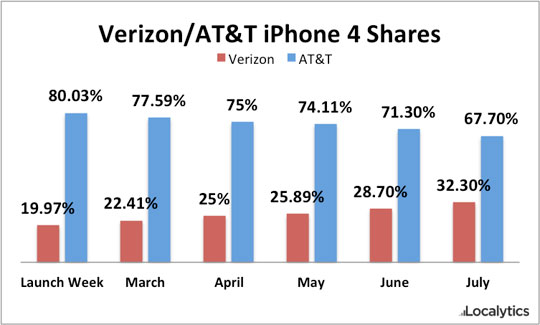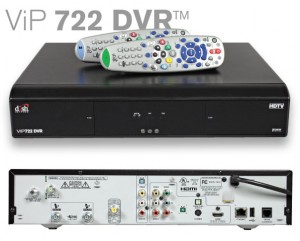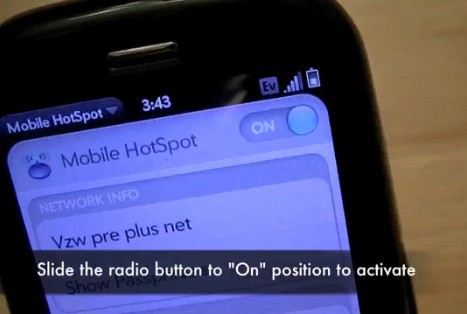 We have received dozens of e-mails from readers trying to add Verizon Wireless’ coveted 4G $30 unlimited-use Mobile Hotspot feature to their accounts, with varying results. We’ve compiled, with the help of our readers, a guide to assist you in scoring the only good thing to come from Verizon’s recent changes in data pricing. If you follow these steps, you should be good to go.
We have received dozens of e-mails from readers trying to add Verizon Wireless’ coveted 4G $30 unlimited-use Mobile Hotspot feature to their accounts, with varying results. We’ve compiled, with the help of our readers, a guide to assist you in scoring the only good thing to come from Verizon’s recent changes in data pricing. If you follow these steps, you should be good to go.
Q&A
1. What is a Mobile Hotspot and What Is Verizon offering? — Verizon Wireless offers customers a service to turn their 3G or 4G phones into a Wi-Fi provider, letting you connect your other portable devices, like a tablet or laptop, to your Verizon Wireless data connection to access the Internet over Wi-Fi. Technically, this feature is built-in to most smartphones, but cell phone companies monetize it by charging you an extra monthly fee to use the service. Traditionally, Verizon charges $20 extra a month (on top of your data plan) to enable this feature, and has limited it to 2GB of use per month. Each additional gigabyte will cost you $10. But when Verizon introduced its new 4G LTE network, early adopters to 4G phones got access to this feature for free, for a limited time. On 7/7, Verizon’s new limited-use data plans took effect, and Verizon expired the free 4G Mobile Hotspot feature. To placate 4G owners, it offered them the chance to continue getting unlimited use of this feature, for an extra $30 a month.
That’s a stiff price to pay on top of your monthly data plan, but because Verizon’s LTE network is currently fast enough to serve as a home broadband backup (we consistently get speeds of 11/3Mbps on LTE from our headquarters), $60 total for unlimited wireless Internet isn’t completely outrageous at those speeds. Yes, it’s ridiculous Verizon disabled a feature built in and functional on phones in other countries, but it is the same story with other carriers as well. We even agree with the proposition you should be able to use your unlimited data plan for anything you want, but that’s just not a reality at the moment.
2. Who exactly qualifies for the $30 unlimited Mobile Hotspot? — We have been able to confirm for sure that anyone who activated or at least ordered a 4G phone before midnight on 7/7 is qualified to upgrade to this plan. You cannot, however, activate the plan on a 3G phone. Only 4G models qualify. Where things get murky is whether or not customers who currently have 3G phones can still upgrade to a 4G model after 7/7 and get this plan. Droid Life believes the answer to this question may be “yes” based on two tweets sent from Verizon Support:
 We are more skeptical, however, based on the accumulated responses we’ve collected from Verizon Wireless from our readers, which admittedly are all over the map. Verizon reps have not been offering consistent information about the Mobile Hotspot plan since it was first announced more than a week ago. The company is preoccupied with reassuring existing customers they were not at risk of imminently losing their unlimited data plans, an entirely different subject.
We are more skeptical, however, based on the accumulated responses we’ve collected from Verizon Wireless from our readers, which admittedly are all over the map. Verizon reps have not been offering consistent information about the Mobile Hotspot plan since it was first announced more than a week ago. The company is preoccupied with reassuring existing customers they were not at risk of imminently losing their unlimited data plans, an entirely different subject.
I would not upgrade to a 4G phone today in hopes of scoring this Mobile Hotspot plan unless you have the name of an employee you can use if you complete the order, try to activate the feature, and encounter resistance. In truth, Verizon can do anything they want for any customer, new or otherwise. The trick is finding an employee with the authority to make things happen. Be prepared to escalate or call back if you encounter a roadblock.
3. What happens if I have a 4G phone and start a Hotspot session with a 3G signal, is it still unlimited? — Yes. Any Mobile Hotspot session originated on this plan on a 4G phone is unlimited regardless of what network conditions you encounter, as long as you are on Verizon’s network.
4. Does this apply to mobile broadband, provided by a dongle or a MiFi device? — No. Only 4G smartphones qualify for this plan.
5. How many people can share my Mobile Hotspot connection at the same time? — Verizon traditionally says five, but my phone (Samsung Charge) supports up to 10 concurrent Hotspot connections. That’s a lot, so if everyone piles on, expect some slowdowns from the shared connection.
6. Can you add and drop the featured plan and get it back later? — Verizon has not said. The company has not responded to questions about the longevity of this plan, whether it could be withdrawn, or whether customers can add and drop it (and add it back) at will. We see that as evidence this is a promotional add-on that is likely to be withdrawn for new customers at some point in the future. Verizon traditionally grandfathers customers already on a plan indefinitely, which means if you have it, you can keep it. If this feature is important to you, we recommend you add it and keep it active. When it’s gone for new sign-ups, it’s gone.
7. I do not see the plan under Verizon’s My Services on their website. Should I be concerned? — No. The plan was being offered to customers initiating new Mobile Hotspot sessions on their 4G phones, but not to all. We never found it on Verizon’s website. The only indication it is active on your account is finding this: “4G SMARTPHONE HOTSPOT” listed on this page (to access, you must first login to your Verizon Wireless account and select the line on which the feature was ordered.)
 Ordering Advice
Ordering Advice
We have found multiple methods of securing this plan, and with the thanks of Stop the Cap! reader DJ, we have even located the all-important plan number, which you can reference when contacting Verizon. If you run into a roadblock calling Verizon customer service, or can’t get the plan added while visiting a Verizon Wireless corporate store, we have some other suggestions.
1. Customers who already had a 4G phone before 7/7 can call Verizon Wireless from your phone at 611 or 1-800-922-0204 Monday-Sunday 6am-11pm ET. Tell them you wish to add plan code #76153 — $30 Unlimited 4G Mobile Hotspot.
2. If you activated a new 4G phone after 7/7, call VZW’s Orders & Activations Hotline at 1-877-807-4646. Work through the prompts. You may be prompted to accept a customer agreement and get “trapped” in a menu asking you to press “1” or “2” after accepting the customer agreement. Press “0” and wait to be transferred to a live agent. Tell them you wish to add plan code #76153 — $30 Unlimited 4G Mobile Hotspot.
3. If rebuffed by either, try calling 1-316-681-9940, the number to a Verizon store in Kansas that has employees active in several phone forums helping people trying to get on this plan. They should be able to add the plan to any 4G phone account, whether you are in Kansas or not. Again, reference plan code #76153 — $30 Unlimited 4G Mobile Hotspot.
Let us know if you still have any problems in our comments section!


 Subscribe
Subscribe







